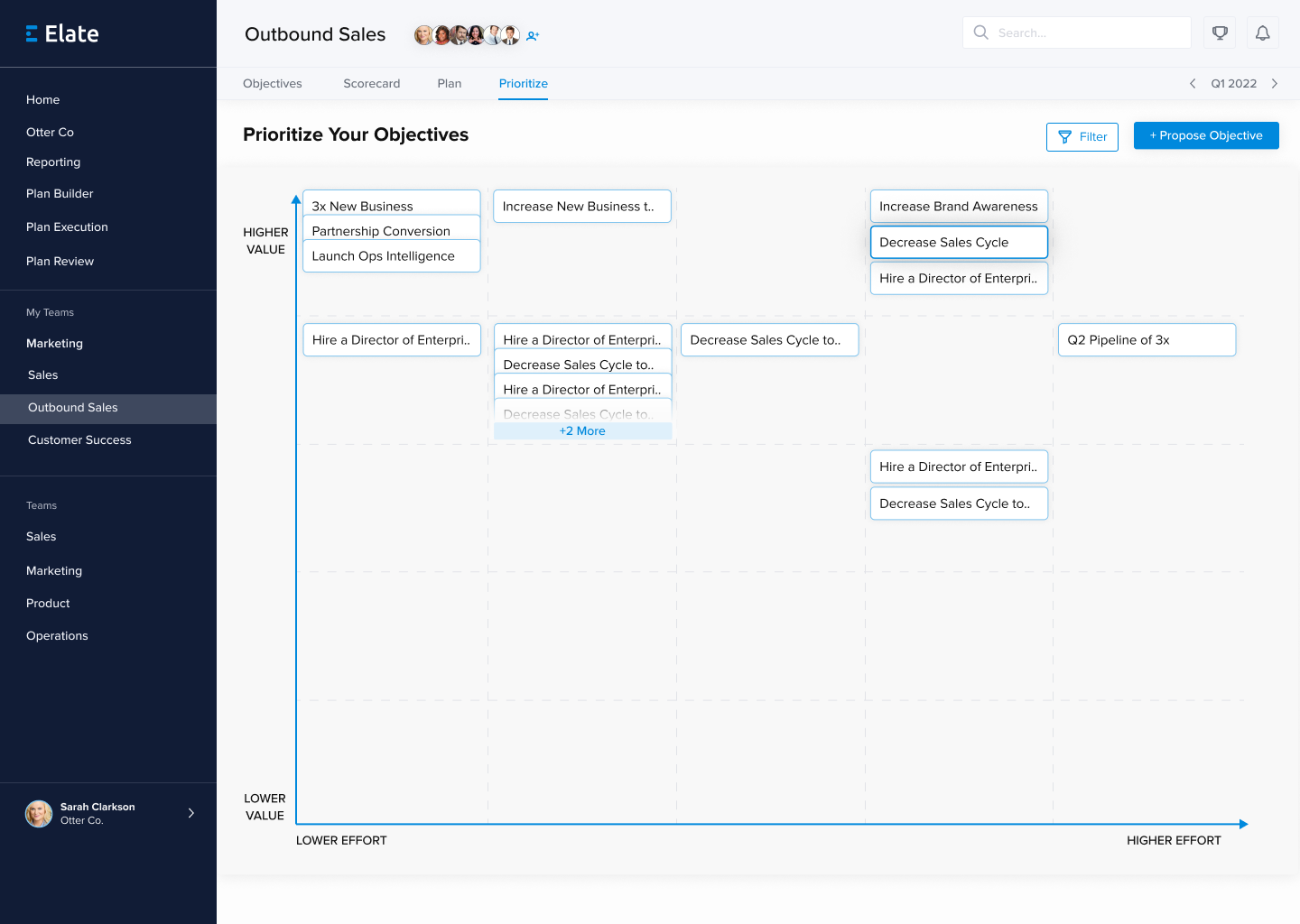
The Four Common Challenges of Strategic Planning
Why Strategic Planning Breaks Down for Many Teams
Strategic planning is a team sport. Done well, it brings every part of the organization together to connect vision with execution. It turns big ideas into aligned priorities that guide where time, energy, and focus should go.
But for many companies, the strategic planning process still feels harder than it should. Despite best intentions, teams often struggle to turn strategy into results. Plans stall, priorities drift, and alignment fades.
At Elate, after reviewing thousands of strategic plans and working alongside hundreds of organizations, we’ve found that the same four challenges tend to show up again and again. Understanding these pitfalls early is the best way to build a planning process that is structured, adaptable, and capable of driving real execution.
So, we built this guide to help Strategy and Operations Leaders identify the most common challenges before they happen and build a planning process that stays clear, aligned, and resilient.
Let’s dive in.
1. The Myth of Strategic Planning Standards
Strategic planning may be universal, but it’s rarely uniform.
Every organization has its own culture, rhythm, and approach to building a strategic plan. That flexibility is natural. But the lack of shared standards often leads to overcomplication and confusion.
At its core, strategic planning is the delivery system for organizational success. When results are achieved, it’s because the strategy worked. When they’re not, the organization succeeds despite it.
Why a Lack of Framework Creates Confusion
Without clear standards, teams often struggle to:
- Understand how leadership expects plans to be structured
- Connect high-level goals to day-to-day work
- Maintain consistency across departments
When everyone builds plans differently, alignment falls apart quickly.
How to Build a Common Foundation That Scales
The goal isn’t to make every strategic plan identical. It’s to build a repeatable framework that:
- Connects leadership’s operating plan to team-level initiatives
- Creates a shared language for goals and outcomes
- Makes it easier to review progress consistently
Keep it simple. Keep it structured. Strategy doesn’t need to be a snowflake to be effective.
Related Resources:
- Operating Rhythm Guide
- Learn how Plan Analyzer helps build a consistent planning framework.
- Explore Hierarchy View to connect leadership goals to team-level work.
2. Without Clarity, Strategy Falls Apart
A strategic plan is only as strong as its measurable outcomes.
Most organizations can state their goals, but they struggle to define what success actually looks like for each objective. Without clarity, alignment becomes impossible.
Why Measurable Outcomes Matter
Teams need targets that:
- Are tied to real business value
- Have clear definitions for success
- Are owned by individuals or teams
If outcomes aren’t measurable, they become opinions rather than commitments.
The 70/30 Rule for Stronger Objectives
We’ve found the most effective balance to be:
- 70 percent measurable outcomes
- 30 percent tactical progress metrics
This ensures your plan reflects results, not just activity.
.png)
Related Resources:
- See how AI-powered status updates bring clarity to objectives
3. Priority Fatigue Is Killing Your Plan
Priority overload is one of the silent killers of strategic execution.
Most employees don’t suddenly wake up overwhelmed. It builds slowly. Teams say yes to too many initiatives because they lack the context needed to say no. When everything feels urgent, nothing is truly strategic.
What Causes Priority Overload
Priority fatigue increases when:
- Objectives aren’t clearly connected to strategy
- Teams lack visibility into what others are working on
- Leaders don’t reinforce what matters most
Without shared visibility, prioritization becomes guesswork.
How Shared Visibility Drives Alignment
True prioritization starts with clarity. When teams have a shared view of:
- What is being prioritized
- Why it matters
- How their work contributes to outcomes
…they make better decisions, move faster, and stay focused on the right things.
Plans rarely fail because teams aren’t working hard enough. They fail because teams are working on the wrong things.
Related Resources:
- Plan Analyzer highlights what’s distracting teams from real priorities

4. Why Static Strategic Plans Fail
The most overlooked part of strategic planning isn’t building the plan. It’s keeping it alive.
Markets shift. Goals evolve. Teams change. Yet many organizations treat strategy as a one-time event instead of a living, breathing system.
Strategy Should Be a Living System
A static plan quickly becomes outdated and irrelevant. When it’s not updated regularly:
- Teams lose engagement
- Goals drift
- Risks go unnoticed
- Execution slows
The best organizations treat planning as ongoing, not annual.
The Role of an Operating Cadence
A strong operating cadence ensures that:
- Strategy stays at the center of the business
- Key risks are surfaced early
- Teams review progress consistently
- Decisions happen faster
The best plans aren’t perfect from day one. They evolve through consistent engagement.
Related Resources:
- Reporting Assistant keeps strategy front and center with automated reporting
- Risk Navigator helps identify slippage early so your plan stays dynamic
- Guide to building an operating rhythm
Learn More About Building a Stronger Strategic Planning Process
At Elate, we’ve helped hundreds of Strategy and Operations Leaders build plans that drive real execution. Our platform, powered by AI-driven insights, helps teams stay aligned, focused, and proactive throughout the year.
If you’re ready to build a dynamic strategic planning process that evolves with your organization, we’d love to connect.
Related Resources:
- Request a demo of Strategy Advisor
- Explore how Strategy Advisor supports dynamic planning
Frequently Asked Questions
What are the biggest challenges in strategic planning?
The most common challenges include unclear outcomes, lack of a consistent framework, priority overload, and treating strategy as a static document instead of an evolving system.
Why do strategic plans fail?
Plans fail when teams lack alignment, measurable outcomes, visibility into priorities, or an operating cadence to keep the plan alive.
How often should a strategic plan be reviewed?
Most organizations review strategy quarterly, but the highest-performing teams use a monthly or biweekly operating cadence to identify risks early and adjust quickly.
How can leaders improve alignment during strategic planning?
Use a shared planning framework, define measurable outcomes, provide visibility into priorities, and adopt consistent review rhythms that keep strategy top-of-mind.
What is an operating cadence in strategic planning?
An operating cadence is the structured rhythm of strategic reviews, updates, and decision-making that ensures the plan remains relevant and actionable throughout the year.



